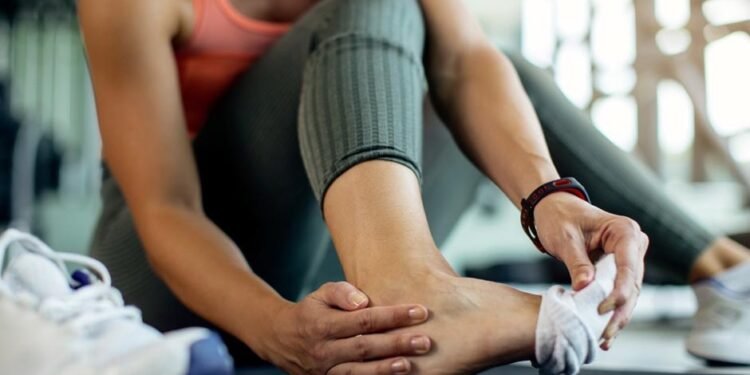Maintaining optimal foot and knee health is essential for overall well-being and mobility. Our feet and knees bear the weight of our bodies and facilitate movement, making them susceptible to various issues over time. Problems with these vital body parts can significantly impact daily life, from discomfort to debilitating conditions. However, finding relief and restoring comfort is possible through informed approaches and practical solutions.
Understanding Common Foot and Knee Problems
Pain relief gel helps to recover numerous factors that can contribute to foot and knee discomfort, ranging from lifestyle choices to underlying medical conditions. Some of the most common issues include:
- Arthritis: A condition that is distinguished by inflammation of the joints, arthritis can affect both the feet and knees, leading to pain, stiffness, and reduced mobility.
- Plantar Fasciitis: This ailment involves inflammation of tissue that connects heel bone to the toes, resulting in heel pain and discomfort, primarily upon waking or after long periods of standing.
- Knee Osteoarthritis: This is also known as degenerative joint, this form of arthritis affects the knees, causing pain, stiffness, and swelling, particularly during movement.
- Flat Feet (Pes Planus): Individuals with flat feet lack arches in their foot structure, leading to pain and discomfort, particularly in arch and heels.
- Patellar Tendinitis: Common among athletes, this condition involves inflammation of tendon connecting the kneecap to the shinbone, resulting in knee pain, especially during activities that involve jumping or running.
The Journey to Relief
Embarking on the journey to happy feet and knees requires a multifaceted approach that addresses symptoms and underlying causes. Here are some effective strategies to consider:
Consultation with a Healthcare Professional
Seeking guidance from a qualified healthcare professional, like a podiatrist or orthopedic specialist, is crucial for accurate diagnosis and personalized treatment recommendations. They can assess your condition, conduct relevant tests, and provide insights into the most suitable interventions for your needs.
Proper Footwear Selection
Wearing supportive and comfortable footwear is important for alleviating foot and knee discomfort. Choose shoes that provide adequate arch support, cushioning, and stability, especially if you have flat feet or are prone to overpronation. Avoid footwear with high heels or insufficient padding, as these can exacerbate existing issues.
Incorporation of Orthotic Inserts
Orthotic inserts, known as shoe inserts or insoles, can enhance foot support and alignment, reducing knee strain and promoting proper gait mechanics. These inserts are available in several materials and designs to accommodate different foot conditions and shapes, providing customized relief for individuals with specific needs.
Physical Therapy and Exercise
Engaging in targeted physical therapy and exercises can strengthen the muscles surrounding the feet and knees, improving stability, flexibility, and overall function. A trained therapist can design a tailored exercise program to address your unique concerns and gradually alleviate discomfort while preventing further injury.
Weight Management
Maintaining a good weight is important for reducing stress on the feet and knees, as excess body weight can exacerbate existing conditions and increase the risk of developing new ones. Adopting a balanced diet and regular exercise can support weight management efforts and improve overall joint health.
Embracing a Pain-Free Future
Individuals can journey toward happy feet and knees by implementing all these strategies and seeking professional guidance. Prioritizing foot and knee health through proactive measures and lifestyle adjustments can improve comfort, mobility, and quality of life. Remember, finding relief is possible, and the first step starts here.
Exploring Alternative Therapies
In addition to treatments that were done traditionally, exploring alternative therapies like acupuncture, massage therapy, and chiropractic care can offer additional relief for foot and knee discomfort. These modalities focus on restoring the balance and promoting natural healing mechanisms within the body, complementing conventional approaches for comprehensive care.
Incorporating Mind-Body Practices
Mind-body practices like yoga, tai chi, and meditation can help manage pain, reduce stress, and improve overall well-being. These gentle forms of exercise promote relaxation, mindfulness, and body awareness, contributing to better pain management and enhanced mobility for individuals with foot and knee issues.
Practicing Proper Posture and Body Mechanics
Maintaining good posture and body mechanics is important for preventing strain and injury to the feet and knees. Be mindful of postures when standing, sitting, and walking, and practice ergonomic principles to reduce unnecessary stress on these vulnerable joints. Simple adjustments in daily habits can make a difference in preventing discomfort and promoting long-term joint health.
Pain relief gel offers targeted relief by delivering active ingredients directly to the affected area, bypassing the digestive system and providing rapid and localized relief. When applied topically, the gel penetrates the skin to alleviate discomfort associated with various conditions, including muscle strains, joint pain, and arthritis. The cooling or warming sensation produced by the gel helps to numb the area, reducing sensations of pain and discomfort. Additionally, many pain relief gels contain anti-inflammatory ingredients that work to reduce swelling and inflammation, further enhancing their effectiveness. By providing quick and targeted relief, pain relief gel enables individuals to manage their symptoms more effectively, allowing them to resume their daily activities with greater comfort and mobility.












